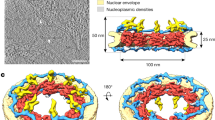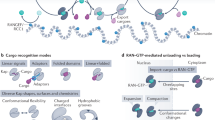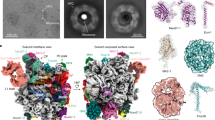Abstract
Two distinct steps in nuclear envelope assembly can be assayed in vitro1–3: the protein-mediated binding4 of nuclear-specific vesicles to chromatin, and the subsequent fusion5 of these vesicles to enclose the chromatin within a double nuclear membrane. Nuclear vesicle fusion, like fusion in the secretory pathway6,7, requires ATP8,9 and cytosol1,3,5 and is inhibited by nonhydrolysable GTP analogues1,2. The sensitivity of nuclear vesicle fusion to GTP-γS requires a GTP-dependent soluble factor, the properties of which are strikingly similar to a GTP-dependent Golgi binding factor (GGBF) that inhibits Golgi vesicle fusion in the presence of GTP-γS and belongs to the ADP-ribosylation factor (ARF) family of small GTPases10,11. In the presence of GTP-γS, ARF proteins and α-, β-, γ-, δ-COP (‘coatomer’) subunits are associated with Golgi transport vesicles6,12,13, but the exact roles of ARF proteins in secretion are not yet understood. We report here that purified ARF1 and GGBF have GTP-dependent soluble factor activity in the nuclear vesicle fusion assay. Our results show that the function of ARF is not limited to the Golgi apparatus, and indicate that there may be a link between the formation of nuclear vesicles during mitosis and proteins involved in secretion.
This is a preview of subscription content, access via your institution
Access options
Subscribe to this journal
Receive 51 print issues and online access
$199.00 per year
only $3.90 per issue
Buy this article
- Purchase on Springer Link
- Instant access to full article PDF
Prices may be subject to local taxes which are calculated during checkout
Similar content being viewed by others
References
Boman, A. L., Delannoy, M. D. & Wilson, K. L. J. Cell Biol. 116, 281–294 (1992).
Newport, J. & Dunphy, W. J. Cell Biol. 116, 295–306 (1992).
Pfaller, R., Smythe, C. & Newport, J. Cell 65, 209–217 (1991).
Wilson, K. L. & Newport, J. J. Cell Biol. 107, 57–68 (1988).
Lohka, M. J. & Masui, Y. J. Cell Biol. 98, 1222–1230 (1984).
Rothman, J. E. & Orci, L. Nature 355, 409–415 (1992).
Melançon, P. et al. Cell 51, 1053–1062 (1987).
Newmeyer, D. D., Lucocq, J. M., Bürglin, T. R. & DeRobertis, E. M. EMBO J. 5, 501–510 (1986).
Vigers, G. P. A. & Lohka, M. J. J. Cell Biol. 112, 545–554 (1991).
Taylor, T. C., Kahn, R. A. & Melançon, P. Cell 70, 69–80 (1992).
Kahn, R. A., Kern, R. G., Clark, J., Gelmann, E. P. & Rulka, C. J. biol. Chem. 266, 2606–2614 (1991).
Serafini, T. et al. Cell 67, 239–253 (1991).
Stearns, T., Willingham, M. C., Botstein, D. & Kahn, R. A. Proc. natn. Acad. Sci. U.S.A. 87, 1238–1242 (1990).
Weiss, O., Holden, J., Rulka, C. & Kahn, R. A. J. biol. Chem. 264, 21066–21072 (1989).
Kahn, R. A. J. biol. Chem. 266, 15595–15597 (1991).
Schleifer, L. S. et al. J. biol. Chem. 257, 20–23 (1982).
Orci, L. et al. Cell 64, 1183–1195 (1991).
Donaldson, J. G., Lippincott-Schwartz, J. & Klausner, R. D. J. Cell Biol. 112, 579–588 (1991).
Pelham, H. R. B. Cell 67, 449–451 (1991).
Kahn, R. A. et al. J. biol. Chem. 267, 13039–13046 (1992).
Balch, W. E., Kahn, R. A. & Schwaninger, R. J. biol. Chem. 267, 13053–13061 (1992).
Lenhard, J. M., Kahn, R. A. & Stahl, P. D. J. biol. Chem. 267, 13047–13052 (1992).
Donaldson, J. G., Cassel, D., Kahn, R. A. & Klausner, R. D. Proc. natn. Acad. Sci. U.S.A. (in the press).
Ercolani, L. et al. Proc. natn. Acad. Sci. U.S.A. 87, 4637–4639 (1990).
Donaldson, J. G., Kahn, R. A., Lippincott-Schwartz, J. & Klausner, R. D. Science 254, 1197–1199 (1991).
Beckers, C. J. M. & Balch, W. E. J. Cell Biol. 108, 1245–1256 (1989).
Mayorga, L. S., Diaz, R. & Stahl, P. D. Science 244, 1475–1477 (1989).
Warren, G. Trends Biochem. Sci. 10, 439–443 (1985).
Mellman, I. & Simons, K. Cell 68, 829–840 (1992).
Lohka, M. J. & Masui, Y. Science 220, 719–721 (1983).
Author information
Authors and Affiliations
Rights and permissions
About this article
Cite this article
Boman, A., Taylor, T., Melançon, P. et al. A role for ADP-ribosylation factor in nuclear vesicle dynamics. Nature 358, 512–514 (1992). https://doi.org/10.1038/358512a0
Received:
Accepted:
Issue Date:
DOI: https://doi.org/10.1038/358512a0
This article is cited by
-
Involvement of HTLV-I Tax and CREB in aneuploidy: a bioinformatics approach
Retrovirology (2006)
-
Arf1
AfCS-Nature Molecule Pages (2005)
Comments
By submitting a comment you agree to abide by our Terms and Community Guidelines. If you find something abusive or that does not comply with our terms or guidelines please flag it as inappropriate.



